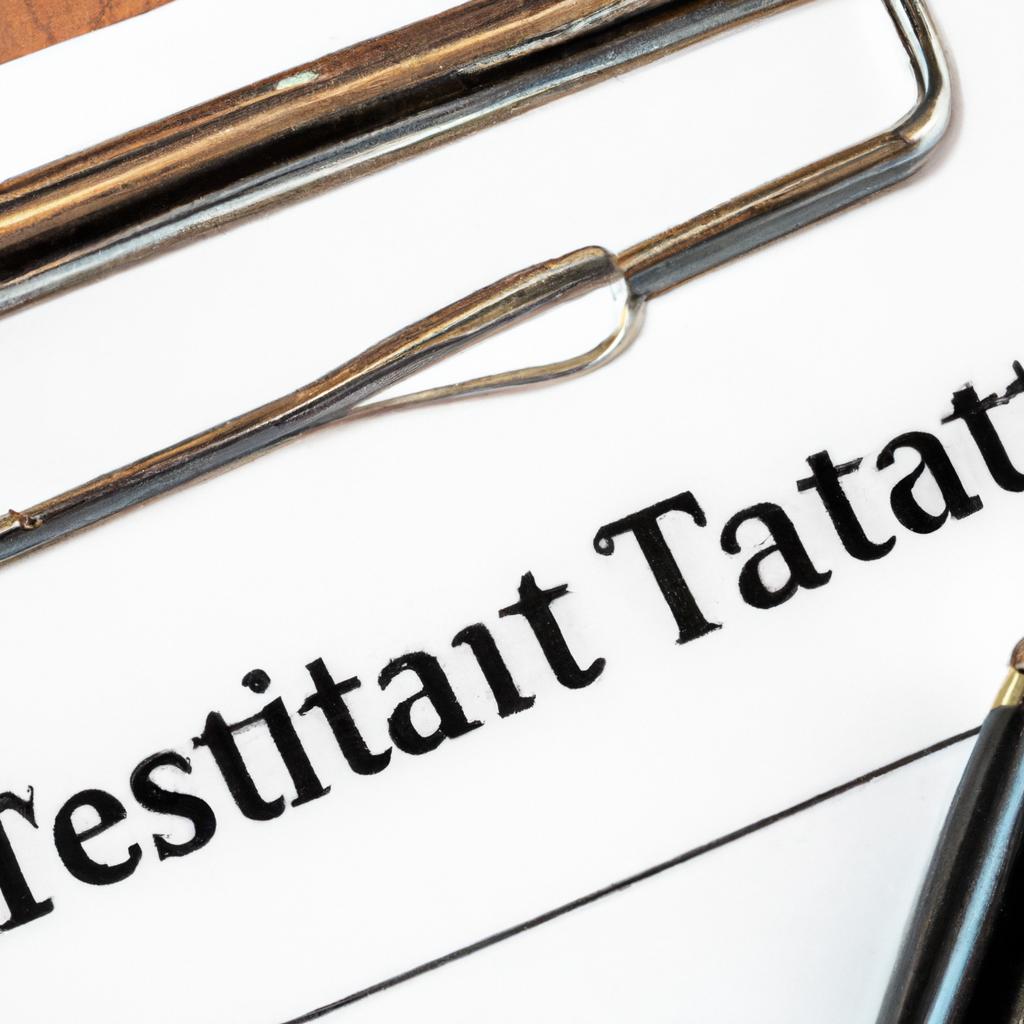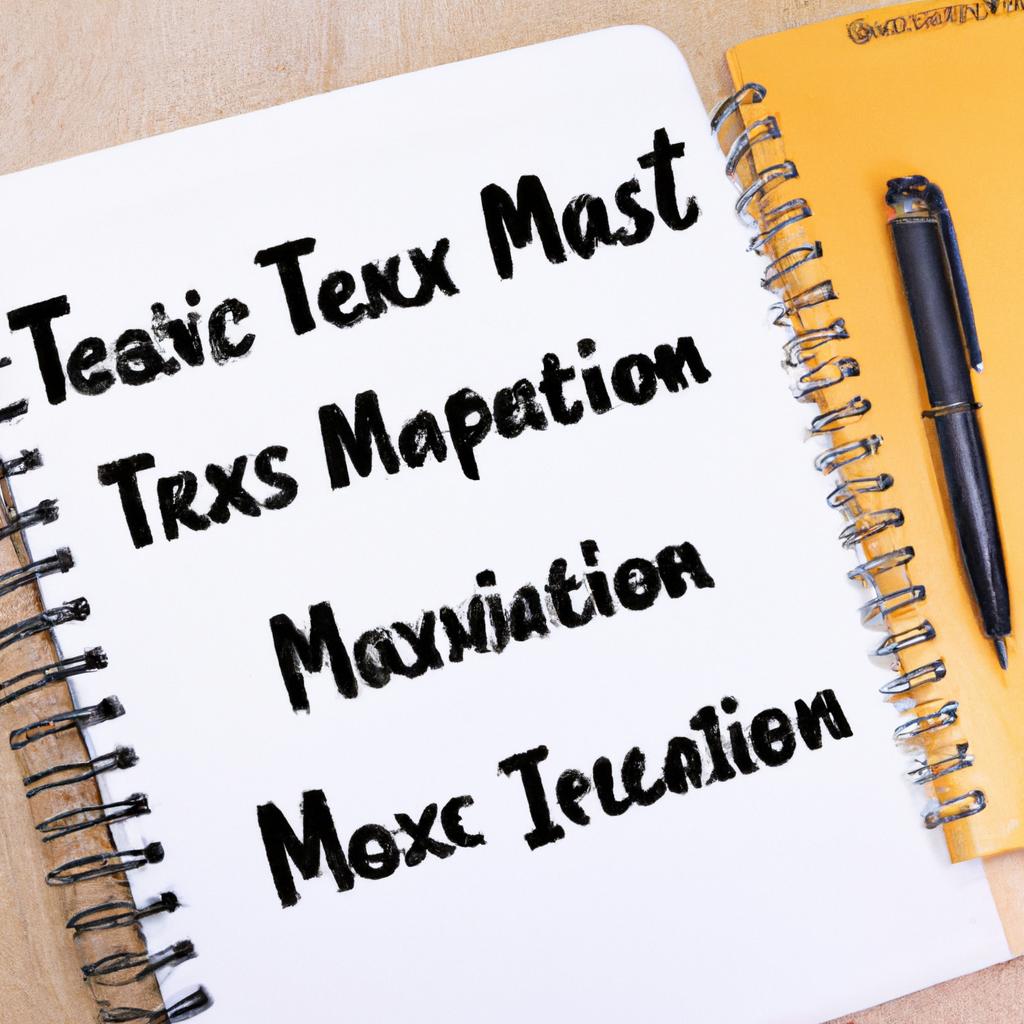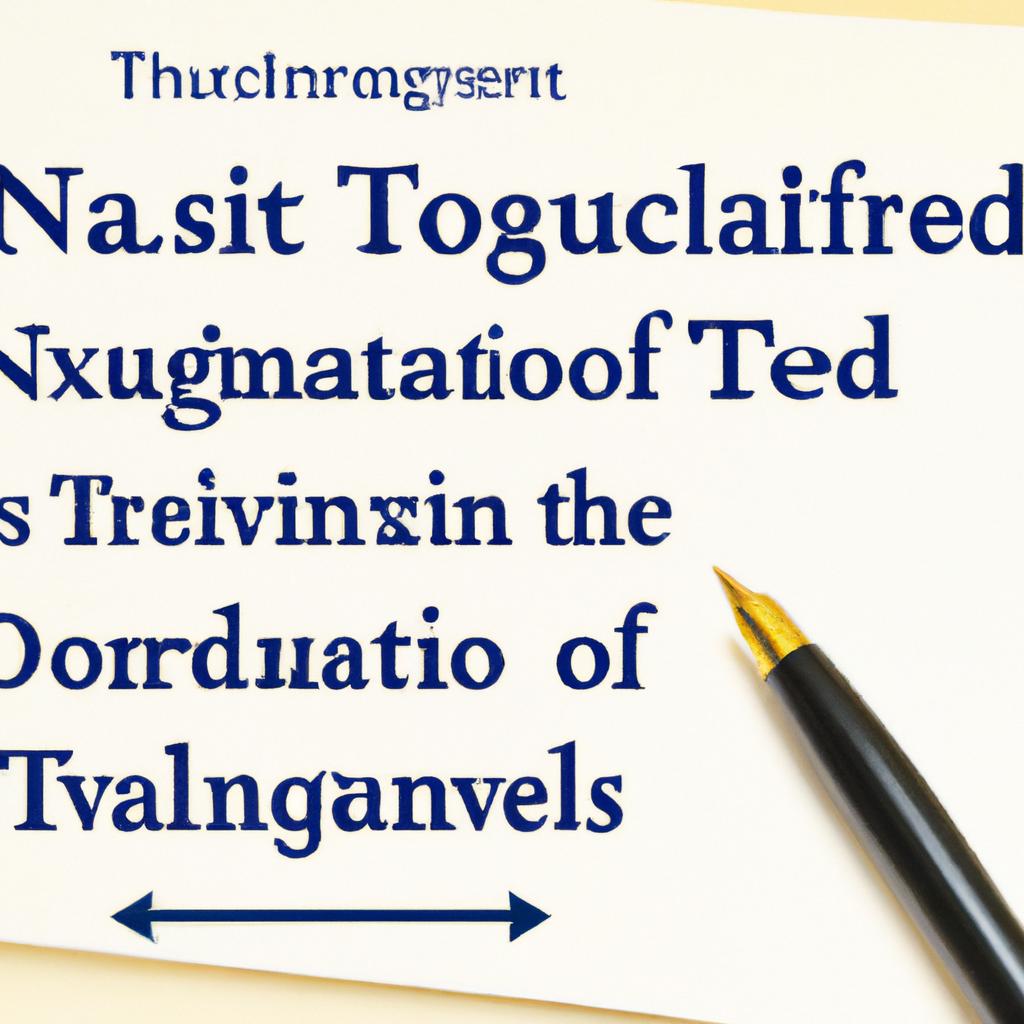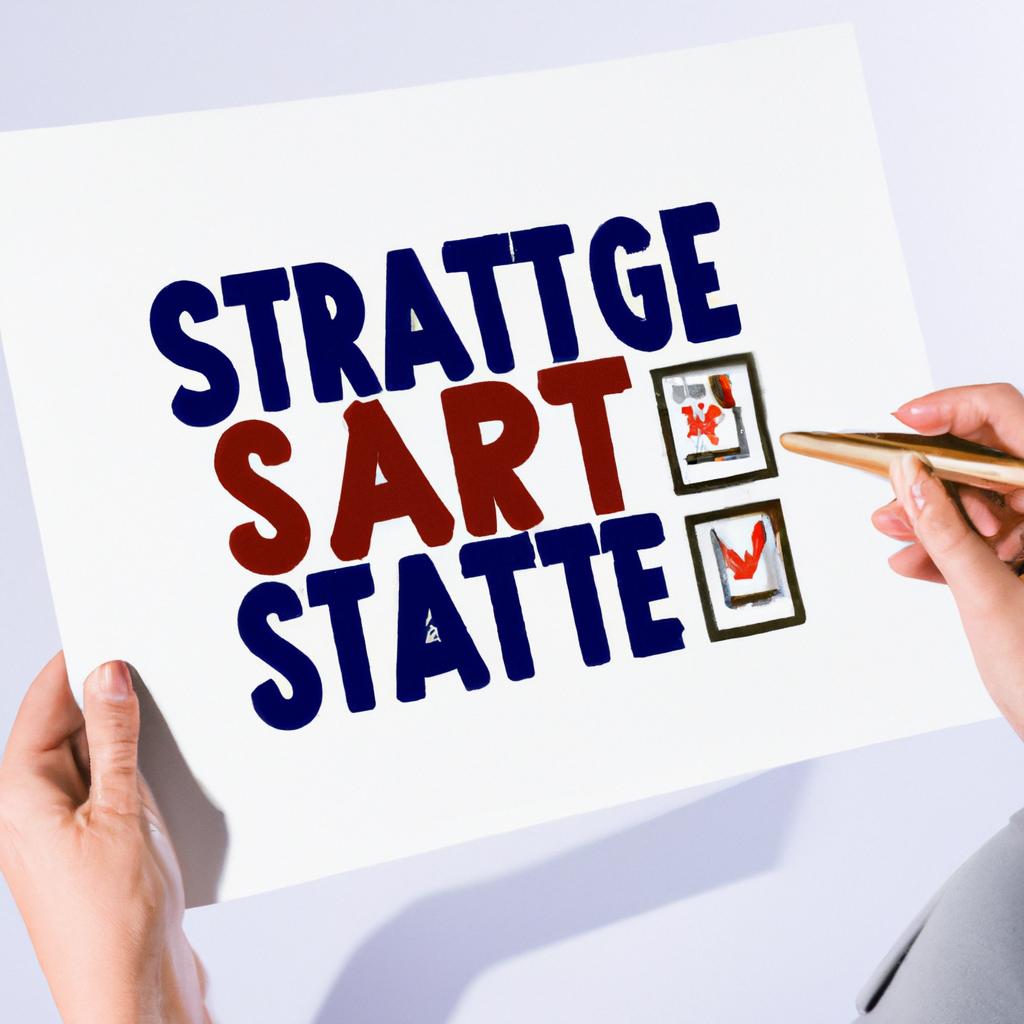In the complex and intricate world of estate planning, trust restatement forms serve as a vital tool for ensuring the proper management and distribution of assets. At Morgan Legal Group in New York City, we understand the importance of these documents in safeguarding our clients’ financial futures. With expertise in estate planning, probate, elder law, Wills, and trusts, our team is well-equipped to guide you through the process of trust restatement with precision and care. Join us as we delve into the intricacies of trust restatement forms and the pivotal role they play in shaping your estate plan.
Ensuring Compliance with Legal Formalities in Trust Restatement Forms
When it comes to trust restatement forms, ensuring compliance with legal formalities is of utmost importance. Trust restatements can be complex legal documents that require meticulous attention to detail to ensure that they are valid and legally enforceable. Failure to comply with legal formalities can result in the trust being deemed invalid, which could have serious consequences for the trust and its beneficiaries.
One way to ensure compliance with legal formalities in trust restatement forms is to work with an experienced estate planning attorney. An attorney can help review the trust restatement form to ensure that it complies with all legal requirements and is properly executed. Additionally, an attorney can provide guidance on any specific legal formalities that may apply to the trust restatement form, helping to ensure that the trust is legally sound and will be upheld in court if challenged. By taking the time to ensure compliance with legal formalities, you can help protect the integrity of the trust and provide peace of mind for both the trust grantor and beneficiaries.

Maximizing Flexibility and Security Through Trust Restatements
When it comes to , it is essential to understand the importance of updating your trust documents to reflect your current wishes and circumstances. A trust restatement form allows you to make changes to your trust without having to create an entirely new trust document. This can save time and money, while ensuring that your trust continues to meet your needs and goals.
With a trust restatement form, you can easily modify provisions of your trust, such as beneficiaries, trustees, and distribution instructions. This flexibility allows you to adapt to changing family dynamics, financial situations, and estate planning goals. By keeping your trust up to date through trust restatements, you can have peace of mind knowing that your assets and loved ones will be protected according to your wishes.

Navigating the Complexities of Trust Modification with Expert Guidance
When it comes to navigating the complexities of trust modification, it is crucial to seek expert guidance to ensure that the process is done correctly and legally. Trust modification can involve a variety of factors, such as changing beneficiaries, adjusting distribution percentages, or updating trustee appointments. Without proper guidance, you may risk making errors that could have serious implications for the trust and its beneficiaries.
One common method used to modify trusts is through a trust restatement form. This form allows trustees to make changes to the trust document without revoking the entire trust. A trust restatement form is a valuable tool that can help ensure that your trust reflects your current wishes and circumstances. With the assistance of experienced professionals, such as our team at Morgan Legal Group, you can navigate the process of trust modification with confidence and peace of mind.

Strategic Considerations for Updating Trust Arrangements Effectively
When it comes to updating trust arrangements effectively, there are several strategic considerations that must be taken into account. One of the most important factors to consider is the current state of the trust and whether a trust restatement form may be necessary. Trust restatements can be a useful tool for making changes to a trust without completely revoking and re-creating it.
Some key considerations to keep in mind when updating trust arrangements include ensuring that all changes comply with current laws and regulations, clearly defining the goals and objectives of the trust, and communicating effectively with all parties involved. By carefully considering these factors and utilizing tools such as trust restatements when necessary, individuals can ensure that their trust arrangements are updated in a way that meets their current needs and objectives.
Q&A
Q: What is a trust restatement form?
A: A trust restatement form is a legal document used to make changes or updates to an existing trust without completely rewriting the entire trust agreement.
Q: Why would someone use a trust restatement form?
A: Trust restatement forms are used to reflect changes in the trustor’s wishes, beneficiaries, assets, or other circumstances without invalidating the original trust document“>original trust agreement.
Q: Are trust restatement forms legally binding?
A: Yes, trust restatement forms are legally binding when properly executed according to state laws.
Q: Can a trust restatement form be used to remove or add beneficiaries?
A: Yes, a trust restatement form can be used to remove or add beneficiaries to a trust.
Q: How does a trust restatement form differ from a trust amendment?
A: A trust restatement form completely replaces the original trust agreement, while a trust amendment simply makes changes to specific provisions within the existing trust.
Q: Is a trust restatement form permanent?
A: Yes, a trust restatement form becomes the new governing document for the trust until another restatement or amendment is made.
Key Takeaways
In conclusion, trust restatement forms are valuable tools that allow individuals to make changes to their trusts without the need for a complete overhaul. By updating key details and provisions, individuals can ensure that their trust continues to align with their wishes and goals. Whether you are looking to revise beneficiaries, update distribution instructions, or make other adjustments, trust restatement forms offer a convenient and efficient solution. Don’t let outdated trust documents stand in the way of your estate planning objectives – consider a trust restatement form today.
 Trust Restatement Form: An Essential Tool for Keeping Your Estate Plan Up to Date
Trust Restatement Form: An Essential Tool for Keeping Your Estate Plan Up to Date
As we go through our lives, our financial circumstances, family dynamics, and personal wishes can change significantly. Therefore, it is crucial to periodically review and update our estate plans to ensure that our assets are distributed according to our current wishes after our passing. For this reason, many people choose to create a trust as part of their estate plan. And while trusts can be a valuable tool for managing and distributing assets, they also require careful attention and maintenance. One way to ensure that your trust stays current and effective is by using a trust restatement form. In this article, we’ll dive into everything you need to know about trust restatement forms, what they are, why you need one, and how to get started.
What is a Trust Restatement Form?
A trust restatement form, also known as a trust modification form or a first amendment to a trust, is a legal document used to amend or update certain provisions of an existing trust without revoking the entire trust instrument. Trusts are typically created to hold and manage assets, with the eventual distribution of those assets to beneficiaries upon the trust creator’s death. However, as previously mentioned, life changes can be fluid, and creating a trust that remains stagnant may not accurately reflect your current wishes. That’s where a trust restatement form comes in.
Why Do You Need a Trust Restatement Form?
As your life changes, so will your assets, family relationships, and overall wishes for how you want your wealth to be distributed. These changes may include buying or selling properties, changing your marital status, having more children or grandchildren, or even changing your mind about who you want to benefit from your trust. If you established your trust several years ago, it’s safe to assume that your life and circumstances have evolved since then. While a trust restatement form may not be necessary every time your life changes, it’s crucial to have this option available in case your trust needs a makeover.
Moreover, if you created a trust with another party, such as a spouse or business partner, and that individual passed away, you might need to modify the trust to reflect your solo ownership. Similarly, if your trust exists in a state that has changed its laws, you may need to revise it to stay compliant with current regulations. Lastly, if your trust has become too cumbersome or complex to manage effectively, a trust restatement form can be used to simplify and streamline it.
How Does a Trust Restatement Form Work?
When you decide to update your trust by using a trust restatement form, there are a few essential steps you need to take to ensure everything is executed correctly. First, you must review your original trust document to identify the sections you want to amend. Next, you need to make sure that the requested changes are legal and valid in your state. Once this is confirmed, you will need to prepare the actual trust restatement form. The form should include details about your current trust, the changes you wish to make, and the provisions you are amending. It should also include the date and signature from a notary public or a witness, depending on your state’s requirements.
To make sure that your trust restatement form is legally binding and valid, it’s essential to consult with an attorney who specializes in trust law. They can review your original trust and the proposed amendments, confirm that the changes are legal and provide guidance on the necessary steps for executing the form properly.
Benefits of Using a Trust Restatement Form
There are plenty of benefits to using a trust restatement form, including:
1. Flexibility: A trust restatement form gives you the opportunity to update your trust without revoking the entire instrument. This means you can amend specific provisions without altering the overarching structure of your trust.
2. Cost-Efficiency: As compared to creating a new trust, using a trust restatement form is significantly more cost-effective. It saves you the time, money, and effort required to create a new trust from scratch.
3. Customization: Trust restatements can be tailored to suit individual needs and unique circumstances. You can add or modify provisions that reflect your current wishes and ensure that your trust accurately reflects your goals.
4. Time-Saving: By using a trust restatement form, you can quickly and efficiently update your trust without having to start from scratch. This can save you a significant amount of time compared to creating a new trust.
5. Privacy and Control: Trusts are private documents that are not typically made public. Therefore, by using a trust restatement form, you can maintain your privacy and have control over who has access to your updated trust document.
Practical Tips for Using a Trust Restatement Form
1. Review Your Trust Regularly: As life changes, make it a habit to periodically review your trust and make any necessary amendments using a restatement form.
2. Consult with an Attorney: As mentioned earlier, it’s crucial to seek the advice of an attorney who specializes in trust law to ensure that your trust restatement form is legally binding and complies with state laws.
3. Notify Beneficiaries: In most states, you are not legally required to notify your beneficiaries of trust restatements; however, it’s always best to keep them informed about any changes in your estate plan to avoid confusion and potential disputes.
4. Keep Good Records: Maintain proper records of all your trust documents, including the original trust, previous restatements, and amendments, to ensure that everything is up to date and in order.
5. Keep Your Trust Restatement Form Simple: While using a trust restatement form gives you the flexibility to make changes, it’s essential to keep your trust document as simple and straightforward as possible to avoid conflicts and confusion in the future.
In Conclusion
Creating a trust is an important step in protecting your assets and ensuring that your loved ones are taken care of after your passing. However, life is unpredictable, and your trust may need some adjustments as your circumstances change. A trust restatement form is a valuable tool that gives you the flexibility to amend and update your trust as needed. By using a trust restatement form, you can ensure that your trust accurately reflects your current wishes and provides peace of mind for you and your loved ones. Consult with a trust attorney to learn more about creating a trust restatement form and keeping your estate plan up to date.

